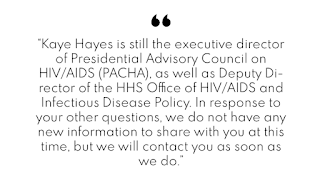The ADAP Advocacy Association hosted an HIV/AIDS "Fireside Chat" retreat in Boston, Massachusetts among key stakeholder groups to discuss pertinent issues facing people living with HIV/AIDS and/or viral hepatitis. The Fireside Chat took place on Thursday, November 8th, and Friday, November 9th, and it built on the previous retreat held in Tampa, Florida earlier in the year.
 |
| Photo Source: Getty Images |
The Fireside Chat included a series of three moderated white-board style discussions about the following issues:
- HIV & Aging
- Drug Importation
- Ryan White Program Reauthorization
The following represents the attendees:
- Tez Anderson, Executive Director & Founder, Let’s Kick ASS (AIDS Survivor Syndrome)
- William E. Arnold, President & CEO of the Community Access National Network (CANN)
- Marcus Benoit, Ryan White Regional Liaison & Eligibility Coordinator, Houston Regional HIV/AIDS Resource Group, Inc.
- Brandon Cash, Theratechnologies
- Jeffrey S. Crowley, Program Director at the O'Neill Institute for National and Global Health Law, Georgetown University Law Center
- Tishna Dhaliwal, Director, Healthcare Policy & Strategy, Johnson & Johnson
- Edward Hamilton, Executive Director & Founder of ADAP Educational Initiative
- Hilary Hansen, Executive Director, Advocacy & Strategic Alliances (US) at Merck
- Stephen R. Hourahan, Executive Director, AIDS Project Rhode Island (APRI)
- Lisa Johnson-Lett, Treatment Adherence Specialist / Peer Educator, AIDS Alabama
- Brandon M. Macsata, CEO of the ADAP Advocacy Association
- Julie Marston, Executive Director, Community Research Initiative (CRI)
- Tim Miley, Associate Director, State Government Affairs – Northeast, Gilead Sciences
- Theresa Nowlin, advocate
- David Pable, Community Co-Chair SC HIV Planning Council
- Samantha Picking, PharmD, RPh, AAHIVP, Healthcare Specialty Supervisor, Walgreens
- David Reznik, Chief, Dental Medicine, Grady Health System Infectious Disease Program
- Alan Richardson, Executive Vice President of Strategic Patient Solutions, Patient Advocate Foundation
- Shabbir Imber Safdar, Executive Director, The Partnership for Safe Medicines
- Carl Sciortino, VP of Government & Community Relations, Fenway Health
HIV & Aging:
Since aging with HIV is not a monolithic, retreat attendees dived into accentuated aging, living with co-morbidities, HIV-related enteropathy and/or peripheral neuropathy, as well as other issues affecting quality of life for the aging HIV population.
The ADAP Advocacy Association would like to publicly acknowledge and thank Tez for facilitating this important discussion.
Drug Importation:
According to Shabbir Imber Safdar, Executive Director, The Partnership for Safe Medicines, there are a wide variety of options for addressing financial impediments to healthcare access. The healthcare supply chain is convoluted and two people that receive the same treatment, test, or medicine often pay wildly different amounts. Not all of these are equally safe for patients.
Shabbir challenged the retreat attendees with a series of questions. First, we must understand the supply chain. How does it work in the US vs other countries? When it fails, how does it fail? What examples of failure exist that we can learn from? How do counterfeits get into our supply chain? Is our drug supply safer or more polluted than other countries? Why is that?
The discussion about the dangers involved with drug importation, including what exactly is the risk of patients breaking the supply chain? Is it just a loss of financial resources? Is a counterfeit that's just a placebo really that dangerous? And beyond the potential dangers, then other issues emerge when obtaining medicine from other countries domestic drug supply. Do they have shortages of their own? Are there other countries large enough to supply medicine to us?
The retreat attendees were also asked, so what's the answer? Can we judge different proposals on the basis of patient safety? Is there any time we want to sacrifice patient safety for access?
The following materials were shared with retreat attendees:
- How Did That Canadian Pharmacy Medicine Get To Me?
- Betty Hunter’s Death Illustrates Danger Of Fake Drugs
- FORTY-THREE STATES AND COUNTING: The Deadly Combination of Imported Fentanyl and Counterfeit Medicines
- Comment: Importing Canadian Drugs Could Harm HIV Patients
- Drug Importation Policy Is A Hard Pill To Swallow
- The Case Against Canada Drugs
- U.S. Drug Importation: Impact On Canada’s Prescription Drug Supply
- Exportation Of Pharmaceuticals From Canada To The United States
Ryan White Program Reauthorization:
The discussion about underserved communities served (or potentially served) by the Ryan White Program was facilitated by Jeffrey S. Crowley, Program Director at the O'Neill Institute for National and Global Health Law, Georgetown University Law Center. The world has changed since the 2009 reauthorization, as Jeffrey noted during this discussion. Research trials definitively have confirmed the benefits of immediate treatment, and the clinical guidelines have also changed. The use of care continuum and monitoring of durability of viral suppression continue to highlight gaps in care. The enactment of the Affordable Care Act (32 states and 62% of the HIV population lives in states that have expanded Medicaid) has changed the healthcare landscape. The 340B Drug Pricing Program is under pressure.
Some of the emerging issues/needs identified included the ongoing role of Ryan White in larger insurance system; early treatment and rapid start of ART/better supports for re-engaging people in care; addressing the needs of an aging HIV population; role of Ryan White in covering PrEP and PEP; Ryan White as a model for or its role in curing HCV and addressing the opioid crisis; and new technology is coming: preparing for long-acting agents.
Finally, Jeffrey led an all important dive into the risks in not reauthorizing versus the risks in reauthorizing the Ryan White Program. The Democrats regaining control of the U.S. House of Representatives certainly changes the dynamics surrounding possible reauthorization.
The following materials were shared with retreat attendees:
- Coverage and Care Pathways for People with HIV: A New Baseline
- HIV and the Opioid Epidemic: 5 Key Points
- Long-Acting HIV Treatment and Prevention are Coming
Additional Fireside Chats are planned in 2019.

















